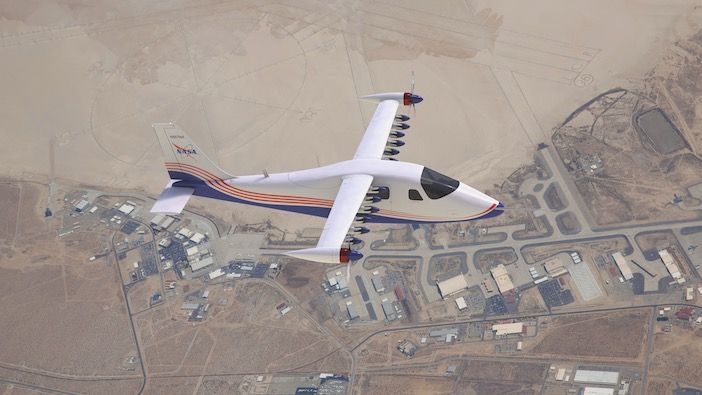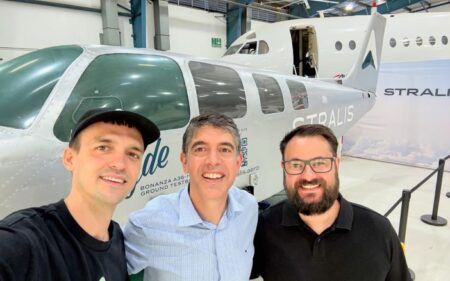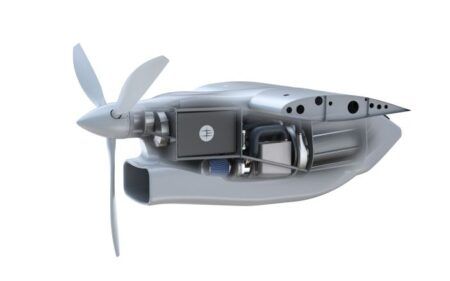The electrification of propulsion systems and the development of new types of aircraft creates commercial opportunities for aviation, but also present many challenges for aerospace engineers.
To those outside of the sector, the introduction of electric and hybrid aircraft, autonomous drones and
air taxis may seem slow. But the industry has built up decades of knowledge and safety evidence for existing designs. To those involved with aerospace development and teting, disruptive aircraft concepts and electric propulsion systems flash up warning signs.
Designs of fixed wing aircraft and rotorcraft are
well-established and well-understood. This includes knowledge about phenomenon such as flutter – the
self-excited vibration of an object, such as an aircraft’s wing, around which air is flowing. Flutter is caused by an interplay of aerodynamics, elastic and inertial forces and can cause aircraft to shake apart.
Ground vibration testing (GVT) is a key part of developing aircraft and ensures aircraft do not suffer from excessive flutter. GVT collects data on how an aircraft vibrates before its first flight, by artificially shaking an airframe and its components. In modern development programs, GVT data is used to update and validate finite element analysis (FEA) models that are used for flutter analysis predictions and certification.
GVT methods and technology has been refined over many years and the body of knowledge regarding modal frequencies and mode shapes grown significantly.
Disruptive technologies and new aircraft flight concepts have to undergo GVT as part of certification. This includes ensuring flutter in new types of aircraft, such as electric and hybrid airplanes and air taxis
is understood and controlled through conducing extensive GVT.
X-57 research
One of the industry’s leading research projects considering flutter and GVT of new aircraft types is NASA’s X-57 aircraft.
The X-57 is a Tecnam P2006T light aircraft that is being incrementally modified by NASA engineers to test electrification technology. In its current configuration, Mod 2, the X-57 has had its standard engines swapped for two all-electric motors powered by batteries.
The NASA research team has already done a round of GVT on the Mod 2 configuration of X-57, which is expected to be flown later this year. After this the stock Tecnam wing will be swapped for a wing developed by NASA that has two large propellers on the wing tips and several smaller propellers distributed along the span of the wing. This Mod 3/4 configuration will also undergo GVT and be flown. The data from X-57 testing will help develop certification standards for electric aircraft.
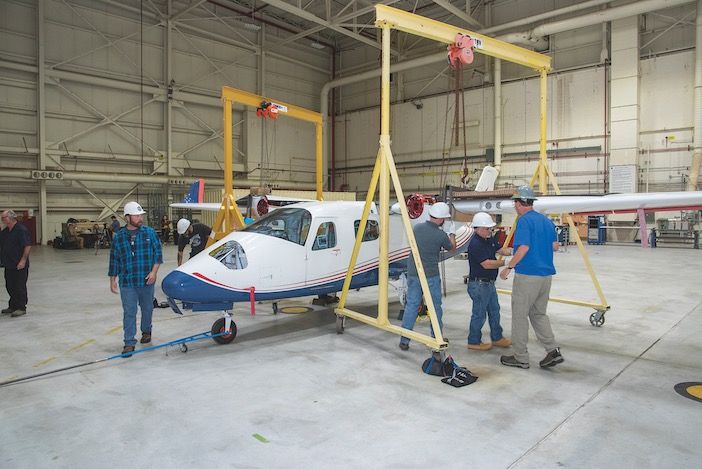
(Image: NASA)
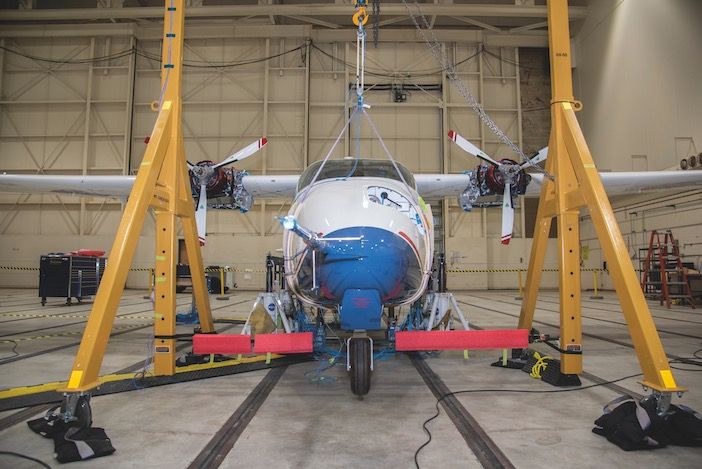
X-57 is not an eVTOL aircraft – it does not take-off and land vertically, but it does have some similar aspects. Keerti Bhamidipati, aerospace engineer at NASA and the current dynamics lead for X-57 says, “It looks like some eVTOL aircraft concepts, but our wings do not tilt. So, the comparison with eVTOL aircraft is not direct, although there are some concerns we share with this design that are mirrored by the tilt-rotor community, such as the two big motors on the wing tips raising structural dynamics concerns.”
In conventional aircraft engineers know that the wing tips are going to vibrate the most. But unconventional design aspects, such wing tip-mounted propellers, create less predictable vibration modes.
Natalie Spivey, an aerospace engineer at NASA within the structural dynamics group who previously led the vibration testing on X-57, says, “The GVT becomes more important in this situation – there has to be more instrumentation, more accelerometers, more cables, more data acquisition channels, because there are so many components.
“Although X-57 isn’t an eVTOL aircraft, we still have all these distributed motors that have modes that interact with the wing. We are collecting more frequencies and mode shapes that couple with the wing.”
According to Spivey GVT is growing in importance with all aircraft types that use composites in airframes because the material makes modeling and validation more complex. But there is an extra layer of complexity introduced with distributing electric motors and propellers around an aircraft.
“Classical flutter is considered to be caused by aircraft torsion and wing coupling interaction, but the extra motors cause whirl flutter, which means you now have two sources of flutter to consider.
“It’s going to differ for every airframe, but whirl flutter is a big driver and hopefully in the future we will see papers from the first companies about how they optimized their configuration.”
NASA will also disseminate what it learns from X-57. Bhamidipati says, “We want to advance the body of knowledge about this part of aviation. The research in X-57 is in the distributed electric propulsion and how to realize a benefit from the multiple propellers and from the higher-efficiency motors and electrical systems.”
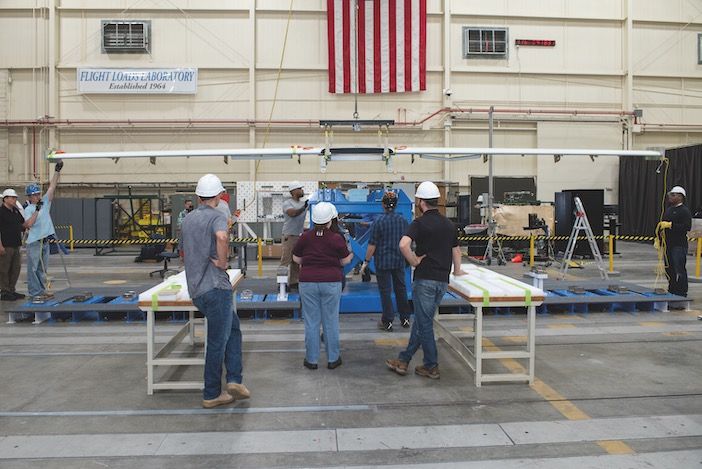
Modal density
Sensors and data acquisition company HBK (Hottinger Brüel & Kjær) supplied the equipment NASA used in its X-57 Mod 2 GVT and is working with several companies conducting vibration testing on eVTOL aircraft.
Stephane Giclais, services and solution principal engineer from HBK has decades of experience with ground vibration testing, especially with helicopters. He says that new electric aircraft mix aspects of rotorcraft, drone and fixed wing design. This mix is reflected in the dynamics of their structural behaviour.
“Electric aircraft are exciting because there are a lot of changes happening to the structure. We are mixing rotorcraft, helicopter and drone designs with fixed wing design, and for GVT that means a mix in.”
Despite that he says the aims of GVT remain the same: “No matter the type of aircraft the objective is always the same – to have the best modal model of the aircraft we are testing. How to achieve that best model will changes a lot with this new type of aircraft.”
Rotorcraft have a high modal density and non-linear phenomenon are also more important, Giclais adds. There is more complexity to the modal parameter instruction and the strategy needed to excite the aircraft and there may be a need to use phased resonance methods, instead of staying in phase separation method. More motors in a design would also mean more excitation considerations to have the most complete modal model.
Accoding to Giclais, compared to the GVT of conventional aircraft there are more structural configurations to test, because of the different engine kinematics. These must represent both the multiple excitations and the mechanical or electrical breakdowns have to be considered for certifications.
Experience matters
Another difference from conventional fixed wing GVT is that the novelty of electric aircraft. This means the entire GVT must be performed, whereas for variant of a commercial aircraft the behaviour of the aircraft and the models have already been done. Experience and a large existing database of test results means only reduced GVT that validates the changes necessary for variants.
Doug Lovelace, business development manager at HBK believes this extra work can be mitigated to an extent with the use of new technology and software. He says, “There are economic pressures to reduce time and optimize GVT. All the new methods and techniques will be used with this new type of aircraft and the technical challenges they pose.
“Our Lan AXI hardware can be distributed around the aircraft and not have long transducer cables trailing around, which makes setup time much faster. We can
go from multiple mainframes to individual modules in one system.
“We can supply the accelerometer, the cables, the data acquisition hardware, the data acqwuisition and analysis software. You don’t have to use all of our system, but we understand the whole measurement chain and the process.”
Lovelace also echoes Spivey’s concerns about whirl flutter. “These electric aircraft are different from classical is that they are all essentially rotorcraft. Whirl flutter becomes more of an issue. When you look at blade pass frequencies for example, they are generating excitations in the aeroelastic frequency ranges of
the aircraft.
“The designs that have engines that change position to transition between vertical and horizontal flight – whirl flutter will be about the stiffness between the nozzle and the attachment to the wing.”
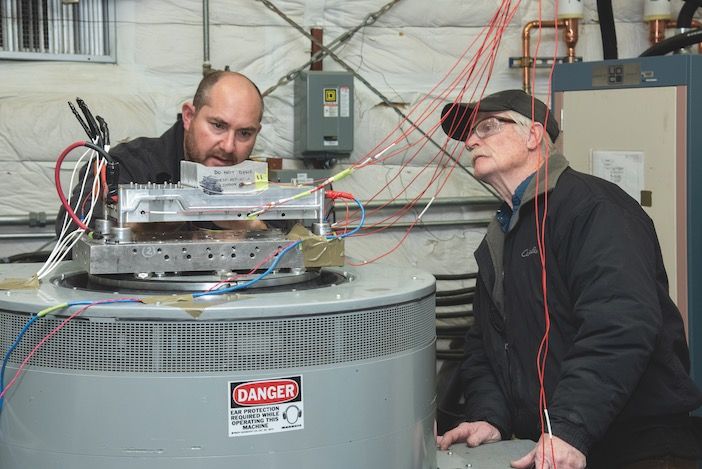
Verification and certification
Siemens has several customers developing VTOLs looking at GVT and the issues around them. They have the most customers at this stage in the USA, where companies like Joby and Kittyhawk.
The company either deploys a team of engineers to carry out the GVT in its entirety or provides the hardware and software, including the data acquisition equipment. This includes system to drive the exciters and shakers and measure, store and process the data for analysis and certification, plus support to varying levels.
Raphael Hallez, aerospace business development manager from Siemens Digital Software believes regulators are aware of the challenges GVT of electric aircraft pose.
“The requirements for flutter verification are still being defined for eVTOL aircraft. In EASA’s special commitment for VTOL and means of compliance there is a chapter on flutter verification which identifies GVT as an important milestone to characterize and understand the dynamic response of the aircraft that will be used to calibrate the simulation models that will be used for flutter simulation.”
Hallez sees new configurations with slender wings and motors and propellers on wing tips and tails as posing structural dynamics issues, such as low frequency torsional modes. Multiple direct driven propellers with fixed pitches but variable rotation speeds can create many different operating conditions, creating issues with whirl flutter. “Even though they are flying at lower speeds and lower altitude, the large number of propellers means whirl flutter has to be examined,” says Hallez. “There lots of combined modes, plus torsional modes that are low frequency that can be more easily excited.
“There are a lot of aeroelastic and rotor dynamics phenomenon that are more closely coupled than on traditional aircraft and a lot of unknowns, including the composite materials being used which are not as
fully understood as metals and produce a lot of
non-linear responses.”
Hallez says engineers can speed up GVT by clearly defining the configurations under test. For example, this could be tilt rotor position if you want to account for the gyroscopic effects of the propellers or defining the propeller speed to investigate coupleing effects between the rotor dynamics and structural dynamics. “Planning is therefore important. It can be helpful to use the model, even before it is calibrated with the pre-test simulation, to determine how many sensors and where to excite,” he says. “You can model the resonate mode and frequencies of the aircraft. You don’t have information on the damping, for that you need the GVT. But once you have that information in Simcenter you can couple the dynamic response of the aircraft with the aerodynamics excitation – run the flutter simulation.”
Comfort counts
Although the focus is on safety with current GVT, as electric aircraft get closer to commercial markets many companies will begin to examine passenger comfort in terms of acoustics.
Hallez says, “We estimate that with distributed propellers there will be less strong coupling like with the helicopter gearbox and the engine, where there is strong coupling. It will be more of an issue in terms of acoustics than vibration.
“People are looking closely at this in terms of acoustics. Some are investing a lot into acoustic testing solutions more than GVT.”


